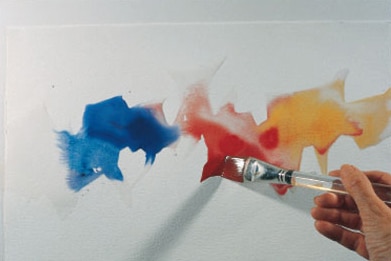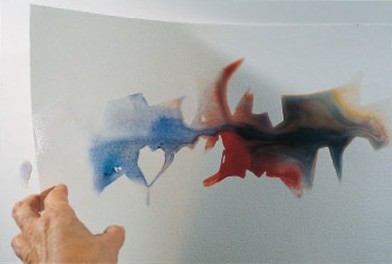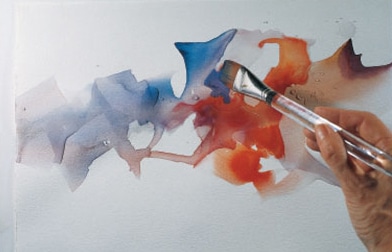I developed this method of floating watercolors into clear water as a result of observing the sometimes fluid interconnection of forms in nature. I apply it in combination with other methods—as an initial layer, on top of an underpainting, or as part of a many-layered painting. The process is undetectable in the finished painting, so it won’t camouflage an artist’s personal style. Complete control is not possible, and the occasional spills force creative solutions! Colors merge in differing proportions, ensuring that no two paintings will be alike.
This technique is useful for quickly laying in subject matter on location, linking forms for better design and building up simple layers into complex paintings. It works well with all sorts of subjects such as trees, figures, cities, flowers and abstract shapes.

Load your brush with water and draw a shape, making sure that it is continuous and touches at least one edge of the paper. Fill in the entire shape with water and use as much water as this “trough” will hold without spilling out. Next, drop transparent pigments onto the water surface.
With this technique, I paint a continuous group of shapes with a brush loaded with clear water, then touch the water surface with another brush filled with transparent pigment. By carefully tipping the paper back and forth before pouring off the excess liquid, I can depict my subject with clean color mixes.

Tip the paper to allow paints to merge. Refine shapes and pour off excess water. Be sure to extend the water and pigment into pleasing and useful (rather than arbitrary) forms before dumping the excess liquid.

Dry thoroughly, then build subsequent layers or complete the painting using your own techniques.

I constantly play with new color combinations to keep my work fresh and unpredictable. Transparent pigments merge and float on the water surface better than opaques, so they’re more suitable for painting with clear water. The DANIEL SMITH Watercolors I use include Anthraquinoid Red, Bordeaux, Carbazole Violet, New Gamboge, Phthalo Turquoise, Rose of Ultramarine, Sap Green and the Quinacridones; Burnt Orange, Coral, Gold, Magenta and Violet.
TIPS: Synthetic flat brushes with good edges are preferable for carrying paint to the edge of the water shape. The point of a round brush can break through the water surface and produce annoying dots of color on the paper. Unstretched 140lb cold-press paper with sizing intact is particularly receptive for maximum retention of water in the “trough” you create.







